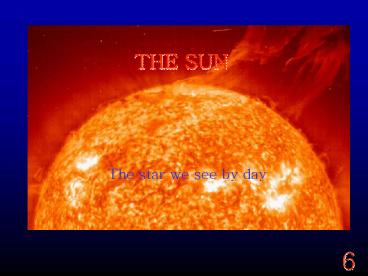THE SUN - PowerPoint PPT Presentation
1 / 31
Title: THE SUN
1
THE SUN
- The star we see by day
2
Goals
- Summarize the overall properties of the Sun.
- What are the different parts of the Sun?
- Where does the light we see come from?
- The scientific method solar neutrinos.
3
The Sun, Our Star
- The Sun is an average star.
- From the Sun, we base our understanding of all
stars in the Universe. - No solid surface.
4
Vital Statistics
- Radius 100 x Earth (696,000 km)
- Mass 300,000 x Earth (1.99 x 1030 kg)
- Surface temp 5,800 K
- Core temp 15,000,000 K
- Luminosity 4 x 1026 Watts
- Solar Day
- 24.9 Earth days (equator)
- 29.8 Earth days (poles)
5
Interior Properties
- Core 20 x density of iron
- Surface 10,000 x less dense than air
- Average density Jupiter
- Core 15,000,000 K
- Surface 5800 K
6
Solar Interior
- Core
- Only place with fusion
- Radiation Zone
- Transparent
- Convections Zone
- Boiling hot
7
In The Core
- Density 20 x density of Iron
- Temperature 15,000,000 K
- Hydrogen atoms fuse together.
- Create Helium atoms.
8
Nuclear Fusion
- 4H ? He
- The mass of 4 H nuclei (4 protons)
- 4 x (1.6726 x10-27 kg) 6.690 x 10-27 kg
- The mass of He nuclei 6.643 x 10-27 kg
- Where does the extra 4.7 x 10-29 kg go?
- ENERGY! ? E mc2
- E (4.7 x 10-29 kg ) x (3.0 x 108 m/s)2
- E hc/l ? l 4.6 x 10-14 m (gamma rays)
- So 4H ? He light!
9
Convection
- A pot of boiling water
- Hot material rises.
- Cooler material sinks.
- The energy from the pots hot bottom is
physically carried by the convection cells in the
water to the surface. - Same for the Sun.
10
Solar Cross-Section
- Progressively smaller convection cells carry the
energy towards surface. - See tops of these cells as granules.
11
The Photosphere
- This is the origin of the 5,800 K thermal
radiation we see. - l k/T k/(5800 K) ? l 480 nm (visible
light) - This is the light we see.
- Thats why we see this as the surface.
12
The Sun
Courtesy of NOAO/AURA
13
The Chromosphere
- Hydrogen most common.
- Brightest hydrogen line Ha.
- Chromosphere color
14
Ha Sun
Photo by Big Bear Solar Observatory
15
Prominences
16
(No Transcript)
17
Corona
- The hot, low density, gas at this altitude emits
the radiation we see as the Corona. - 1,000,000 km
- But corona very faint compared to photosphere.
18
(No Transcript)
19
Solar Wind
- At and above the corona
- Gas is very hot
- Very energetic
- Like steam above our boiling pot of water, the
gas evaporates. - Wind passes out through Coronal Holes
- Solar Wind carries away a million tons of Suns
mass each second! - Only 0.1 of total Suns mass in last 4.6 billion
years.
20
Sunspots
- 11-year sunspot cycle.
- Center Umbra 4500 K
- Edge Penumbra 5500 K
- Photosphere 5800 K
21
Magnetic fields and Sunspots
- At kinks, disruption in convection cells.
- Sunspots form.
22
Magnetic fields and Sunspots
- Where magnetic fields pop out of Sun, form
sunspots. - Sunspots come in pairs.
23
Solar Cycle
- Increase in solar wind activity
- - Coronal Mass Ejections
- Increase in Auroral displays on Earth
- Increase in disruptions on and around Earth.
Courtesy of SOHO/LASCO/EIT consortium.
24
(No Transcript)
25
Aurora
- The solar wind
- passes out
- through the
- Solar System.
- Consists of electrons, protons and other charged
particles stripped from the Suns surface. - When charged particles and magnetic fields
interact light!
26
(No Transcript)
27
(No Transcript)
28
2003 CME
Oklahoma 10/29/2003
Credit E. Woldt
29
Solar Neutrino Problem
- We observe
- Suns luminosity (total light radiated).
- We hypothesize
- 4H ? He light neutrinos
- We can test
- Observe number neutrinos reaching Earth
- Does our test agree with hypothesis?
- No
30
What to Do?
- For 30 years
- Theorists certain of nuclear reaction.
- Observers positive of observations.
- Detected only 1/3 the hypothesized neutrinos.
- What to do?
31
Neutrino Flavors
- 3 types of neutrinos
- Electron neutrino
- Tau neutrino
- Muon neutrino
- Nuclear reactions produce only electron neutrino.
- Previous detectors only detected electron
neutrinos.
32
Neutrino Fluctuations
- New detector (2002) gives number of all three
flavors. - Total number agrees with number predicted in core
of Sun. - Conclusion
- Nuclear hypothesis is correct.
- Neutrinos change flavor.
- Neutrinos have mass (used to be thought
massless). - Problem solved ? new science discovered.
33
Homework 6
- Due Tuesday 2/3
- Read Exoplanet articles.
- (Homework is to read the articles and website.)
- Website is http//www.howstuffworks.com/planet-hu
nting2.htm

